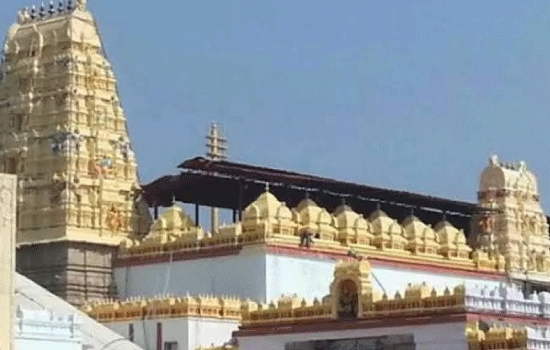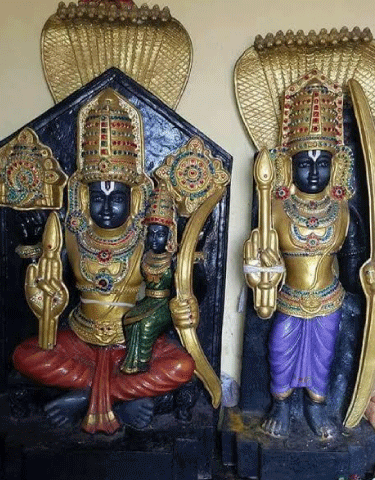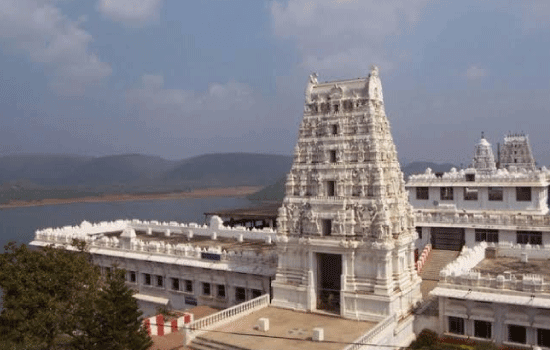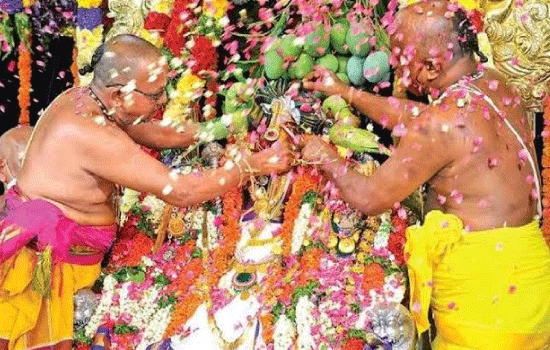Bhadrachalam TempleLord Vishnu, one of the most important gods of the trinity, has many prominent avatars that are mentioned in many different texts by Hindus. One of the most important avatars of Vishnu is Rama. The legacy of Lord Rama is influential over a vast area in different regions of the country, and one such city is Bhadrachalam in the east of Telangana, a town located on the banks of the river Godavari. Sri Sita Ramachandraswamy Temple, popularly known as Bhadrachalam Temple, is a Hindu temple that is located here. This temple is often, referred to as Bhadradri of Bhadrachalam and is considered one of the Divya Kshetrams of Godavari. It is also revered as Dakshina Ayodhya. It is believed that the central icon of the temple has self-manifested, and it features the four-armed Vaikuntha Rama form of the Lord Vishnu. Sita, the consort of Rama, and his brother Lakshmana also form the part of the central icon. 
HistoryAccording to the available historical accounts, there are two versions of the establishment of the temple. According to the first version, Kancherla Gopanna, also known as Bhadrachala Ramadasu, worked as the revenue officer (Tehsildar) under the reign of Abul Hasan Qutub Shah, the last sultan of the Golconda (1672-1686) enforced the religious tax Jaziya by order of sultan. The local Hindus of the area criticized Gopanna, and later, he decided to use some portion of this tax to build the temple in the 17th century. At the same time, the other version states that Gopanna observed the dilapidated state of the temple and decided to repair the temple of Lord Rama. He thought to compensate the portion of taxes by raising donations. The temple's construction or renovation was completed by the second half of the 17th century, which cost around six lakh various. Shah was enraged after learning the truth, and Gopanna was summoned to the court to explain his intention. He was put behind bars as a punishment for 12 years and was ordered that if he didn't repay the amount within 12 years, he should be hanged. During this period of imprisonment, he composes many Bhakti songs that are still sung at the temple. There is a story in this area that when the duration of 12 years was about to complete, Sultan saw lord Rama in his dream along with Lakshmana to pay gold coins and release Gopanna. According to another version of the story, Sultan donated the area surrounding Bhadrachalam as an endowment to the temple and gave a lifetime pension to Gopanna. None of these versions of the story has any backing from historical pieces of evidence. Gopanna used Bhadrachalam to spread awareness of the tradition of Vaishnavism and made it a center of Bhajan tradition. After the death of Gopanna Tumu Lakshmi, Narasimha Dasu (from Guntur) and his friend Varada Ramadasu (from Kanchipuram) spent their life there and offered prayers on a daily basis. Mythology
It is among the several temples in India that have some sort of connection with the famous epic Ramayana legend about Bhadra. According to this, the avatar of Lord Vishnu in the Treta Yuga Rama stayed in the Dandaka Forest along with his wife Sita and brother Lakshmana as a part of his 14-year exile. With the touch of Rama, a stone was turned into a human called Bhadra. Bhadra was also considered to be the son of Mount Meru. Bhadra was completely devoted to Rama and met the sage Narada, who gave him instructions (upadesam) on the Rama Taraka Mantra. He chanted the mantra on the riverbank of Godavari and meditated there for several years. Rama was so pleased with him that he promised to meet Bhadra after he found his wife, who was abducted by Ravana (demon king). Lord Vishnu was pleased by the devotion of Bhadra and appeared before him in the form of Rama as Rama failed to fulfill his promise in his lifetime. However, Vishnu forgot that Rama had two arms as a mortal being and appeared before Bhadra in his celestial form with four arms. Sita seating on his left thigh, and to his left, Lakshmana was standing. There is also another local legend regarding the origin of the temple. According to this, there was a tribal lady named Pokala Dhammakka who lived in Bhadrareddypalem. She is considered to be the descendant of Sabri and found the central icon of Rama in an anthill as she got the location from her dream and dissolved the anthill using the water of the river Godavari. Later with the help of villages, she built a mandapam and offered prayers to the deities. Construction and Architecture
The temple is divided into three different parts. All these three-part of the temple is taken as the different body parts of the Bhadra. The first part of the temple is considered the head of the Bhadra. A white clay called Thirunamam is applied to the rock so that the visitors can recognize it as the head of Bhadra. There is also a shrine that is dedicated to him, and a supposed footprint of Rama can also be seen. The second part of the temple is believed to be equivalent to the heart of Bhadra, and it is a sanctum where the central icon is placed and worshipped. The third part of the temple is the main tower, Rajagopuram, which is located at the feet of the Bhadra. There is four entrance to the temple; to reach the main entrance, one has to climb 50 climbs. A huge door named Vaikuntha Dwaram was built in 1974 to ensure proper management of the visiting devotees. There is a gold-plated flag post-Dwajasthambam directly opposite the sanctum. It is made of a five-metal alloy (Panchaloha) on which the image of Garuda (believed to be the vehicle of Lord Vishnu) is carved. On the top of the tower (Vimana) of the sanctum is the Sudarshana Chakra, which is eight-faced and with thousands of corners. It is believed that Gopanna found it in the river Godavari and engraved it on the temple while building it. The miniature of the deity of the temple can be seen on the Vimana of the temple. The central icon of the temple's sanctum is considered to be Swayambhu (self-manifested). Gopanna installed and consecrated the icon of the reclining form of Vishnu known as Ranganatha, which faces south. This place is famous by the name of Ranganayakula Gutta, which means Hillock of Ranganatha. To follow the tradition of Srirangam Ranganathaswamy Temple, Gopanna included the temple of Lakshmi Thayar opposite the sanctum of Ranganatha. There are many other shrines inside the complex of the temple dedicated to different gods. There are two shrines dedicated to Hanuman the Dasanjaneya temple in the Thiruveedhi (divine passage of Bhadrachalam) and the Abhayanjaneya Temple at the bank of the river. There is another shrine which is dedicated to Yogananda Narasimha, whose icon is believed to be Swayambhu and powerful, the shrine of Govindaraja Swamy, located in the Royal passage Rajaveedhi of the temple. For conducting the marriage ceremony of the Rama and Sita, there is Nithyakalyana Mandapam or Kalyana Mandapam in the outer ambulatory passage of the temple. There is a Rushya Mookham Exhibition center next to the temple of Lakshmi Thayar; different historical items are housed, like Rama made coins given to Shah of Golconda or the different jewelry items that Gopanna made for the deities like Chintaku Patakam (rubies studded necklace), plaited decorations, Kirithas (Crowns), Mutyala Haramu (chain of pearls). Festivals
There are many important festivals and celebrations that are being organized in the temple. Let's see what those different festivals are. Vaikuntha EkadashiTo follow the tradition of the Srirangam Temple, there is a celebration of Vaikuntha Ekadashi. As per the importance of Bhadradri (Bhadradri Kshetram Mahatyam) in Brahma Puran, devotees who seek the blessing of Vaikuntha Rama on the last day of Vaikuntha Ekadashi shall be granted salvation. It is a 21-day king celebration in which the float festival Teppotsavam preludes the Vaikuntha Ekadashi. In the celebration of Teppotsavam, a swan-shaped boat called Hamsavahanam is used for the procession of the Utsav icons on the water of the river Godavari. On the day of the main event, i.e., Vaikuntha Ekadashi, the Utsava icons of three main deities are seated on the Garudavahanam. Rathotsavam and Goda Kalyanam form the other main important activities. The chariot festival Rathotsavam coincides with the festival of Makar Sankranti. VasanthotsavamVasanthotsavam means the festival of spring. It is celebrated to mark the beginning of the preparations for the annual grand celebration of Brahmotsavam. Vasanthotsavam coincides with the festival of Holi. It involves the preparation of the Mutyala Talambralu is done( in which Mutyala is made of petals, and talambralu is a mixture of turmeric and rice used in the rituals of marriage in south India). In this, natural pearls are mixed with turmeric powder and rice grains whose husks have been removed with nails. This mixture, along with aromatic ingredients, is known as Goti Talambralu. The priest of the temple performs the sanctification of the temple known as Maha Kumbhaprokshana. The water which is used in this process is called Vasantha Theertham. It is sprinkled on the devotees, after which the celebration of Holi starts. BrahmotsavamBrahmotsavam is the most important annual festival of the temple. The Vasantha Paksha Prayukta Srirama Navami is a 12-day long festival celebrated from the month of March - to April. Rama Navami is considered to be the birthday of Rama, and it is the main event of the festival. According to the Pancharatra Agama rules, the marriage ceremony of Rama with Sita was also held on this day. The marriage ceremony is performed on a Muhorat that signifies the presence of stars Abhijit and Punarvasu. It is formally referred to as Sri Sitarama Thirukalyana Mahotsavam. The festival of Brahmotsavam starts by performing a special cleansing Visesha Snapanam of the icons, followed by the formal start of Anukurarpanam. A flag made out of white cloth with an image of Garuda ( Dwajapata Bhadraka Mandala Lekhanam) is prepared, and the priest performs special prayers such as Garudanyasam and Garuda Dhyanam. After the flag is placed at the feet of the central icon of the temple, it is taken to the fire altar (Vedi) and placed on a heap of rice. By performing Abhisheka to the flag with 16 Kalash containing sacred water, the procedure gets completed. This ritual is known as Garudadhivasam, which means inviting Garuda. After the completion of this ritual, the priest hoists the flag (Dwajarohanam) and starts a special fire ritual. The festival of Brahmotsavam continued by welcoming the bridegroom, known as the Edurukolu event, before proceeding with the marriage. After releasing Gopanna, the Shah started a tradition of sending gifts to Rama and Sita on the eve of the marriage. These gifts include silk robes and pearls, which are used along with Goti Talambralu in the Thirukalyana Mahotsavam. This tradition was continuously followed throughout Qutb Shahi's reign and followed by all succeeding governments. According to the Telugu tradition, the mangalsutra used in the marriage ceremony of Rama and Sita contains 3 coin-sized gold discs, and each of them has its own significance. One disc pertains to the father of Rama, Dasaratha second pertains to the father of Sita Janak, and the third pertains to the Gopanna as he considered Sita as her daughter. After the rituals of the marriage ceremony are completed, the coronation ceremony known as Mahapattabishekam and Teppotsavam is held. This grand festival end with flower worship known as Sripushpayagam. VijayadashamiOne of the key festivals that are celebrated in the Bhadrachalam Temple is the ten-day Dussehra. The recitation of the verses of Ramayana is done on a daily basis for ten days during the Yagna, which ends on the tenth day known as Vijayadashami. According to the Pancharatra Agama, these rituals are performed in the temple of Lakshmi Thayar. Thousands of devotees visit the Lakshmi Thayar temple on the premises of Bhadrachalam temple for Nijaroopa Darshanam (darshan of true form) on the event of Vijayadashami. They also take out a procession where the idol of Rama is dressed as emperor and placed on vehicles of horses and elephants. The event of the Vijayadashami ends with the tradition of the Ramleela ceremony conducted at night. Other FestivalsThe other important festivals that are celebrated in the temple are Sabri Smruti Yatra, Hanuman Jayanti, Dhamakka Seva Yatra, and Jayanthi Utsavam to celebrate the birthday of Gopanna and Narasimha Dasu is also celebrated annually. SignificanceIt is a renowned and significant temple of Lord Rama in south India. The temple of Bhadrachalam is often referred to as Dakshina Ayodhya. It is also important as there is a unique iconography of Rama in the form of Vaikuntha Rama, which is not found anywhere else across India. It is also considered a special temple (Divya Kshetrams) situated on the bank of the river Godavari. Gopanna used it as a Center to spread awareness about Vaishnavism through his Bhajans. It is also important as it is among the few temples that are connected with the story of Ramayana.
Next TopicBhimashankar Temple
|
 For Videos Join Our Youtube Channel: Join Now
For Videos Join Our Youtube Channel: Join Now
Feedback
- Send your Feedback to [email protected]
Help Others, Please Share










